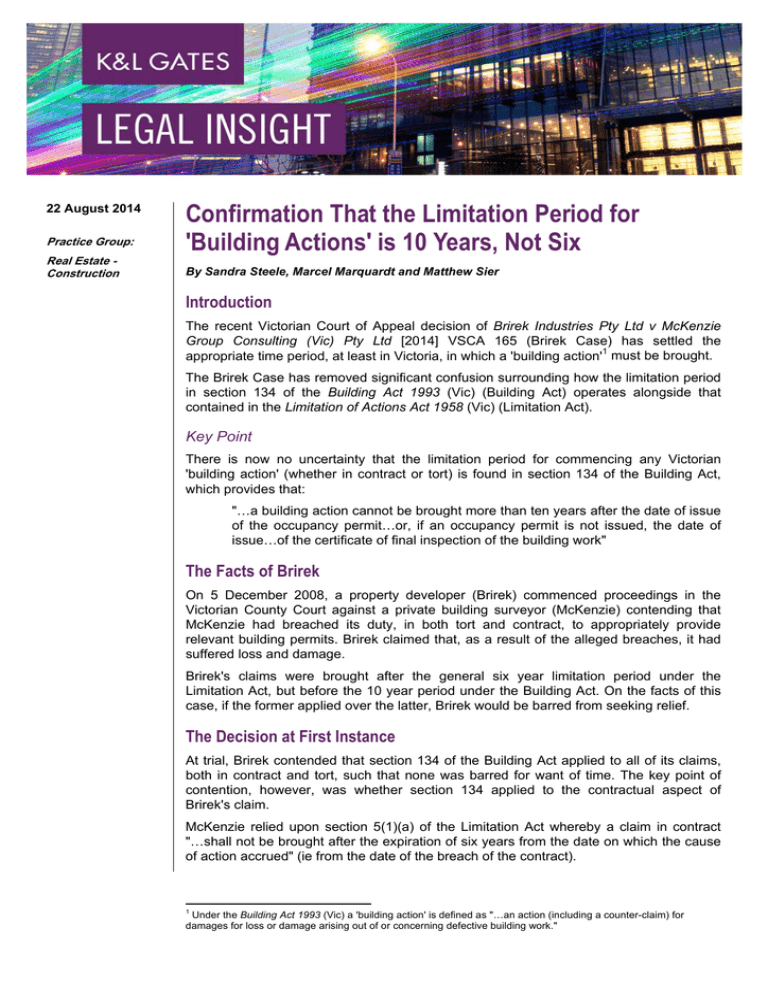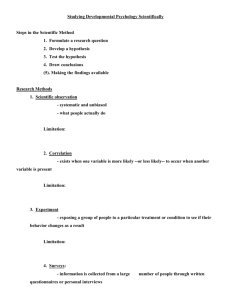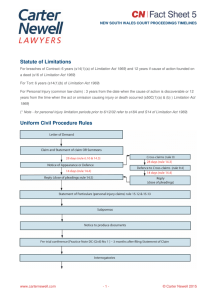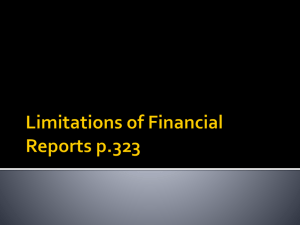
22 August 2014
Practice Group:
Real Estate Construction
Confirmation That the Limitation Period for
'Building Actions' is 10 Years, Not Six
By Sandra Steele, Marcel Marquardt and Matthew Sier
Introduction
The recent Victorian Court of Appeal decision of Brirek Industries Pty Ltd v McKenzie
Group Consulting (Vic) Pty Ltd [2014] VSCA 165 (Brirek Case) has settled the
appropriate time period, at least in Victoria, in which a 'building action'1 must be brought.
The Brirek Case has removed significant confusion surrounding how the limitation period
in section 134 of the Building Act 1993 (Vic) (Building Act) operates alongside that
contained in the Limitation of Actions Act 1958 (Vic) (Limitation Act).
Key Point
There is now no uncertainty that the limitation period for commencing any Victorian
'building action' (whether in contract or tort) is found in section 134 of the Building Act,
which provides that:
"…a building action cannot be brought more than ten years after the date of issue
of the occupancy permit…or, if an occupancy permit is not issued, the date of
issue…of the certificate of final inspection of the building work"
The Facts of Brirek
On 5 December 2008, a property developer (Brirek) commenced proceedings in the
Victorian County Court against a private building surveyor (McKenzie) contending that
McKenzie had breached its duty, in both tort and contract, to appropriately provide
relevant building permits. Brirek claimed that, as a result of the alleged breaches, it had
suffered loss and damage.
Brirek's claims were brought after the general six year limitation period under the
Limitation Act, but before the 10 year period under the Building Act. On the facts of this
case, if the former applied over the latter, Brirek would be barred from seeking relief.
The Decision at First Instance
At trial, Brirek contended that section 134 of the Building Act applied to all of its claims,
both in contract and tort, such that none was barred for want of time. The key point of
contention, however, was whether section 134 applied to the contractual aspect of
Brirek's claim.
McKenzie relied upon section 5(1)(a) of the Limitation Act whereby a claim in contract
"…shall not be brought after the expiration of six years from the date on which the cause
of action accrued" (ie from the date of the breach of the contract).
1
Under the Building Act 1993 (Vic) a 'building action' is defined as "…an action (including a counter-claim) for
damages for loss or damage arising out of or concerning defective building work."
Confirmation That the Limitation Period for 'Building Actions' is 10
Years, Not Six
After placing particular reliance on the second reading speech of the Minister for
Planning on the Building Bill 1993 (Vic), Judge Shelton concluded that section 134 of the
Building Act had no application to a 'building action' based in contract.
His Honour decided that section 134 of the Building Act only applies to claims in
negligence with respect to defective building work and does not extend the six year
contractual limitation period in the Limitation Act, as argued by Brirek.
The Court of Appeal's Decision
On appeal, the Court of Appeal noted that the approach of Judge Shelton was
unnecessarily constrained. Their Honours decided that actions founded in contract,
independent of any tort claim, fall within the scope of section 134 and may be brought
within 10 years from the date of issue of the occupancy permit2.
Outcome of the Decision
The Court of Appeal's decision has now provided decisive guidance on when the
limitation period for a 'building action' begins and when it ends.
The practical results of this decision are:
in the context of a 'building action', the limitation period in section 134 of the
Building Act replaces the limitation period in section 5(1)(a) of the Limitations Act3
insurance and risk management tools must be structured to reflect the six year
limitation period being replaced
building owners must be aware that a contractual or tortious 'building action' must
be commenced within 10 years after the issue of either:
o
the occupancy
or
o
final inspection certificate.
The case may become relevant in New South Wales, the Australian Capital Territory, the
Northern Territory and Tasmania, where legislation containing time limits for commencing
contractual and tortious actions for defective building work differ from the relevant
general limitation acts.4
Conclusion
Building and construction professionals should seek appropriate advice if concerned that
this decision may potentially revive certain 'building actions' previously thought to be
statute barred.
2
Brirek Industries Pty Ltd v McKenzie Group Consulting (Vic) Pty Ltd [2014] VSCA 165, [135].
This decision accorded with earlier interpretations of section 134 given by the Victorian Civil and Administrative
Tribunal: see Thurston v Campbell [2007] VCAT 340.
4
See respectively section 109ZK of the Environmental Planning and Assessment Act 1979 (NSW); section 142 of the
Building Act 2004 (ACT); sections 159 and 160 of the Building Act 1993 (NT); section 73 of the Development Act
1993 (SA); sections 255 and 266 of the Building Act 2000 (Tas).
3
2
Confirmation That the Limitation Period for 'Building Actions' is 10
Years, Not Six
Authors:
Sandra Steele
sandra.steele@klgates.com
+61.2.9513.2528
Marcel Marquardt
marcel.marquardt@klgates.com
+61.2.9513.2524
Matthew Sier
matthew.sier@klgates.com
+61.2.9513.2534
Anchorage Austin Beijing Berlin Boston Brisbane Brussels Charleston Charlotte Chicago Dallas Doha Dubai Fort Worth Frankfurt
Harrisburg Hong Kong Houston London Los Angeles Melbourne Miami Milan Moscow Newark New York Orange County Palo Alto
Paris Perth Pittsburgh Portland Raleigh Research Triangle Park San Diego San Francisco São Paulo Seattle Seoul Shanghai
Singapore Spokane Sydney Taipei Tokyo Warsaw Washington, D.C. Wilmington
K&L Gates comprises more than 2,000 lawyers globally who practice in fully integrated offices located on five
continents. The firm represents leading multinational corporations, growth and middle-market companies,
capital markets participants and entrepreneurs in every major industry group as well as public sector entities,
educational institutions, philanthropic organizations and individuals. For more information about K&L Gates or
its locations, practices and registrations, visit www.klgates.com.
This publication is for informational purposes and does not contain or convey legal advice. The information herein should not be used or relied upon
in regard to any particular facts or circumstances without first consulting a lawyer.
© 2014 K&L Gates LLP. All Rights Reserved.
3





